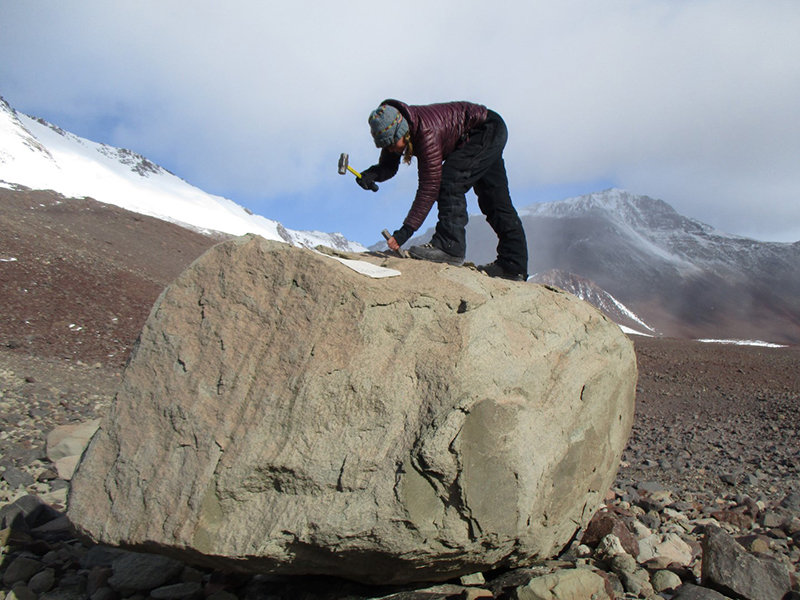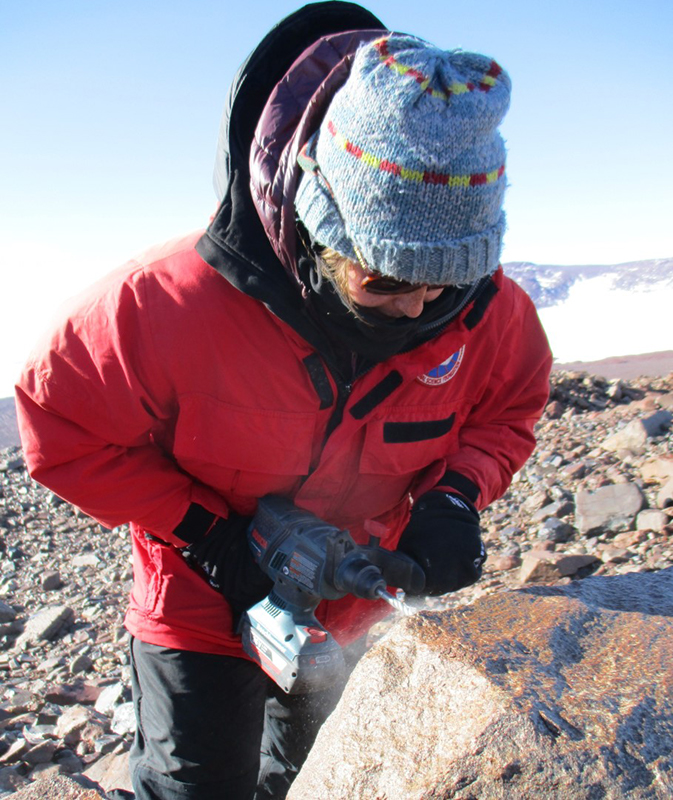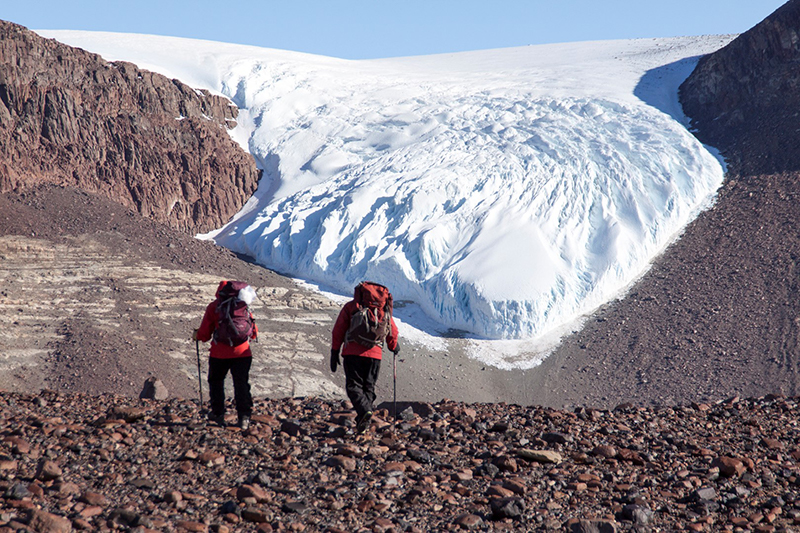Dating the East Antarctic Ice SheetPosted June 14, 2017
The history of the East Antarctic Ice Sheet is written in stones along the Transantarctic Mountains. 
Photo Credit: Gordon Bromley
Two of the researchers survey the section of Shackleton Glacier along Roberts Massif.
Over the past two years, researchers ventured to remote areas along the mountain range to decipher how high ancient glaciers reached, by studying the rocks they left behind. “We go to places that are not now covered by ice, and look for some kind of evidence that they were covered by ice at some point in the past, and try to date it,” said Greg Balco, a glacial geologist at the Berkley Geochronology Center. “We look for glacial deposits, and we use all manner of different means to figure out how old they are.” The team collected samples from these glacial deposits, also known as moraines, which are essentially piles of rocks, sand and dirt left behind by flowing ice. By measuring the amount of cosmic radiation the rocks have been exposed to, the research team can map out the reach of ancient glaciers at different points in the past. “We can compare that to climate records and see how the ice sheet responds to warmer periods, colder periods and things like that,” said Gordon Bromley, a geologist at the University of Maine. Knowing the extent of the ice sheets throughout different climatic conditions over the last 15 million years will offer insights into their possible future as the planet warms from climate change. 
Photo Credit: Gordon Bromley
Lines of ejected stones form moraines, which mark the limit of where the ice sheet once reached.
“We want to know what the East Antarctic Ice sheet did during the Pliocene because that was believed to be warmer than present,” Bromley said. “That, at the moment, is the best analogue we have for the greenhouse future.” Their project is supported by the National Science Foundation, which manages the U.S. Antarctic Program. As a glacier cascades across the landscape, rocks from nearby cliffs fall onto it and it picks up all manner of debris lying on the ground. Those rocks and dirt get embedded in the ice. The internal flow of the glacier gradually pushes that material to the edges of the ice where they fall out, forming moraines along the rim of the glacier. The site where the team traveled this season, Roberts Massif, is a series of ice-free peaks and cliffs that sticks out of the East Antarctic Ice Sheet at the head of Shackleton Glacier. They wanted to visit it because previous surveys showed it is covered in moraines pushed into their present location from the ancient movements of the East Antarctica Ice Sheet. “We use those mountains as a yardstick basically because as the ice sheet grows or shrinks, it goes up and down the sides of these mountains, and it leaves moraines as it does so,” Bromley said. “You can see a whole series of horizontal and sloping lines going up into the sky showing where the ice sheet surface used to be.” 
Photo Credit: Gordon Bromley
Allie Belter chips off a sample of a large stone that was deposited thousands or millions of years ago by now-receded glaciers.
After carefully mapping the moraines, the team set about collecting rock samples from the top of them in order to date when the glaciers last spit out debris. To do so, they have to measure exactly how much radiation from outer space these rocks have been exposed to. Every part of the Earth's surface is constantly exposed to a low level of cosmic radiation from energetic particles, mainly neutrons and protons, originating in outer space. "It zips right through you and me," Bromley said. But if you stack up enough mass in the path of a cosmic-ray particle, the incoming particle eventually hits one of the atoms that make up that mass and stops. "This can be a problem for things like electronics." Balco said. "If you are running a large data center with thousands of server computers, you have to worry about cosmic-ray impacts causing errors every now and then." In the outer layers of exposed rocks, cosmic-ray impacts break apart atoms and produce rare nuclides like beryllium-10 or helium-3, that are not produced by any other natural process. A thick enough layer of glacier ice also stops the cosmic-ray flux, shielding the rocks below from nuclide production. “A stone underneath the ice sheet is protected. It never sees this cosmic-ray flux until the ice sheet spits it out at the side in one of these moraines,” Bromley said. “When it spits it out, it’s suddenly exposed to the cosmic-ray flux and these rare nuclides start to accumulate in the crystals in the rock.” The radiation from outer space is consistent, so rare nuclides accumulate inside an exposed rock at a constant and predictable rate. “If you know the rate at which those nuclides are produced in the rock and you can measure how much you have inside the rock, then you can calculate how long that rock has been exposed on the hillside, exposed to the atmosphere,” Bromley said. “If the rock is part of a moraine, it tells you when that ice was last at that limit.” Walking along the edges of the moraines, the team searched for rocks that look like they haven’t been disturbed since they were spit out of the ice. When they found ones that looks promising, they pulled out their chisels and hammers and chipped off a hunk of rock from the top. “We’re looking for a piece about the size of a big steak,” Bromley said. “If the East Antarctic ice sheet collapsed during the Pliocene, these rocks would have seen it, just because that landscape is so ancient and so stationary.” The continent’s dry conditions are ideal at preserving the kinds of rocks the team is looking for. “In a typical place, a granite boulder will last a couple of hundred thousand years,” Balco said. “In Antarctica we have exposure-dated things that are up to 14 million years old.” 
Photo Credit: Gordon Bromley
Allie Belter drills into a large stone on the ground to extract a sample of it.
They measured the locations of each rock sample using a GPS to predict how much radiation the rocks should have been exposed to. “We need to know exactly the elevation of our sample,” Bromley said. “Imagine if you’re on top of Everest, the atmosphere is very thin, these cosmogenic rays can come zipping through, whereas if you’re down at sea level, the atmosphere is much thicker, so it soaks up a lot of that radiation.” At the end of their two-week stay, they had collected more than 150 samples to ship first to the University of Maine. There, they’ve started processing them and grinding them up to their constituent parts. “We measure [cosmogenic nuclides] in certain minerals,” Balco said. “A rock is composed of a whole bunch of different minerals, so the first thing is to crush the rock and extract the mineral you’re interested in.” Bromley and his team are in the midst of turning the rocks they collected into pure mineral samples using techniques borrowed from the commercial mining industry. “My student and I are wading through them now, just crushing them in the lab, turning them into sand and pulling out the pyroxene crystals,” Bromley said. “That’s where the magic happens.” Pyroxene is a kind of silicate crystal found in many different kinds of igneous rocks, including granite. The team is interested in isolating it from the rock samples they collected because it’s one of a number of different minerals that can be used to analyze the rock’s age. It’s particularly well suited for the helium-3 analysis that is the focus of their work. “A lot of time is taken to separate the different minerals from one another,” Bromley said. “We want the pyroxenes, but we have to get rid of feldspars and other junk.” Separating pure pyroxene crystals is a complex task. First large grinders crush up the rocks to a fine sand. Powerful electromagnets then remove all of the iron material. Pyroxene crystals then have to be separated out using heavy liquids and then doused in a bath of 2 percent hydrofluoric acid to etch away any lingering groundmass. Isolating these crystals is a time-consuming process, and the team likely will spend the better part of a year separating them from the rocks they collected. Each time Bromley is done isolating the pure crystals from a sample, he transfers them to Gregory Balco at the Berkeley Geochronology Center to determine their ages. “We have a huge amount of excess material and that makes me feel good to have it there just in case,” Bromley said. “Ultimately Greg will run maybe 25 milligrams of this stuff for each rock, so it’s a very small amount, but you have to go from that half a kilogram down to that because the one thing we would be kicking ourselves forever is if we didn’t collect enough down there, because we can’t go back.” At the center, Balco uses a mass spectrometer to separate the different nuclides from each other and compare their ratios. The team is primarily focused on the buildup of the stable isotopes helium-3 and neon-21, but there are a number of other radioactive isotopes they’re looking at as well, including beryllium-10. Taken together, all the different data they’re collecting should tell them how long each rock has laid atop the moraine, exposed to the cosmic rays of space. “That’s why Antarctica is cool,” Balco said. “You’ve got this unbelievably old material sitting around at the surface. It's not like anywhere else on Earth” NSF-funded research in this story: Gordon Bromley, the University of Maine, Award No. 1443321. |



For USAP Participants |
For The Public |
For Researchers and EducatorsContact UsU.S. National Science FoundationOffice of Polar Programs Geosciences Directorate 2415 Eisenhower Avenue, Suite W7100 Alexandria, VA 22314 Sign up for the NSF Office of Polar Programs newsletter and events. Feedback Form |



